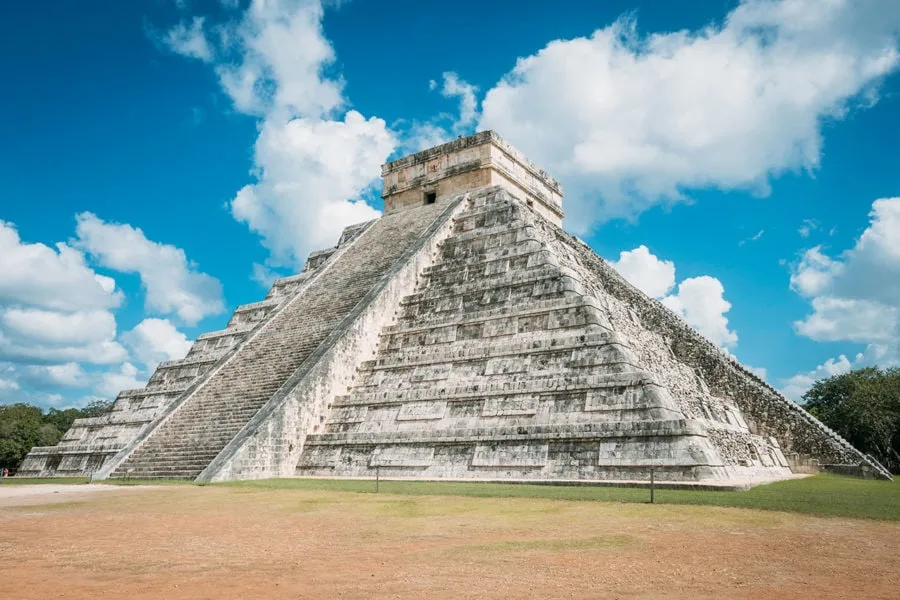
Mexico Culture
One of my favorite parts about traveling in Mexico are all the interesting ancient Mayan ruins to explore. Here are the best Maya archeological sites that you don’t want to miss!
Maya is a lifestyle; a community of settled people who have inhabited areas of Mexico and Central America since around 1800 BC.
Many people assume the Maya were wiped out — which is not the case.
The Maya community today totals around 7 million people who live by the traditions and are still native speakers of the Mayan language – rather than Spanish which now dominates the countries in which they reside.
However Mexico is littered with crumbling Mayan cities built by their late ancestors, pyramids of stone abandoned for various reasons and left to be overtaken by the jungle.
Many Mayan ruins have been excavated and opened to the public — but some, in particular, stand out more than others.
After living in traveling through Mexico for the past 2 years, I wanted to share some of my favorite Mayan ruins & archeological sites in Mexico to see in 2023.
Learn a little bit about the history of these incredible ancient pyramids and historic sites before you explore them on your next trip to Mexico!
- Mayan Ruins Mexico Map
- History Of The Maya
- Mayan Archeological Sites In Mexico
- 1. Chichen Itza Mayan Ruins
- 2. Coastal Ruins Of Tulum
- 3. Maya Ruins Of Coba
- 4. Palenque
- 5. Calakmul Mayan Ruins
- 6. Monte Alban
- 7. Teotihuacan
- 8. Ek Balam
- 9. Uxmal Ruins
- 10. Edzna
- 11. El Rey
- 12. Chacchoben
- 13. Templo Mayor
- 14. Izamal
- 15. El Meco
- Other Important Mayan Sites
- Mysteries Of The Maya
Mayan Ruins Mexico Map
HOW TO USE THIS MAP: Above you’ll find a map of the best Mayan Ruins in Mexico. Click on the top left of the map to find separate layers marking the route and points of interest. You can hide and show different layers, or click icons on the map to see the names of places I mention in this travel guide. “Star” the map to save it to your own Google Maps, or open the map in a new window for a larger version. Enjoy!
History Of The Maya
Agricultural people by nature, the Mayan civilization harvested crops such as maize and beans, clearing jungles for farming as they developed more sophisticated techniques to expand their production.
Spiritually, the Maya worship more than 150 Gods who they believe their Kings are related to; with one God ruling over every subject associated with their lives, for example, the God of Rain, the God of Agriculture, and the God of Death.
Though it may seem complicated to us, this extensive list of deities actually resulted in huge advances in math and astronomy plus the development of the famous Mayan Calendar.
Although the original Maya Empire was destroyed many centuries ago (due to drought, warfare, and/or overpopulation), the Maya people still exist today.
The modern-day Maya hide in plain sight, so to speak, living in Mexico while keeping much of their own traditions and culture from the past.
Mayan Archeological Sites In Mexico
History lesson over, it’s time to dive into the multitude of ancient Mayan ruins – and there are quite a few, with around 200 different sites in Mexico alone!
Over 4000 sites spread out all over Central America.
Work is still ongoing to uncover some of these, as archaeologists are actively engaged in extracting and understanding the secrets of ancient Maya, buried beneath a combination of thick jungle and time.
I’m going to help cut down this number for you, and share what I think are the 15 best Mayan archeological sites in Mexico. Let’s go!
1. Chichen Itza Mayan Ruins
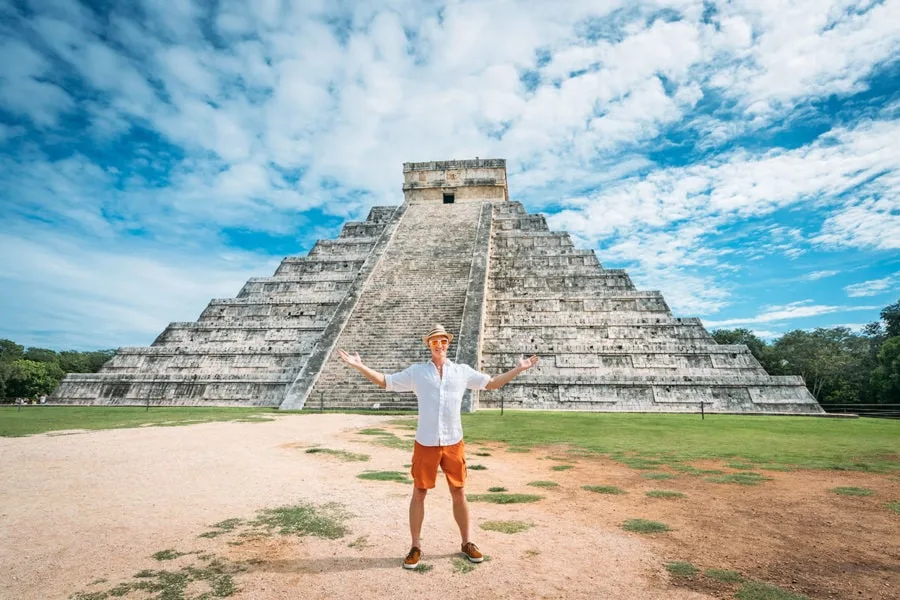
One of the greatest Maya cities in Mexico was Chichen Itza – a sacred city which covers around six square miles and was once home to hundreds of buildings which were built in both the classic Maya period and the later Maya-Toltec period.
Chichen Itza is probably the most visited Mayan ruins in Mexico, since being named one of the New Wonders of the World. The highlight is Kukulkan Pyramid which stands at 75 feet tall and built for astronomical/sacrificial purposes.
Perhaps one of its biggest draws for tourists is the twice-annual equinox when the setting sun creates shadows on the pyramid steps that resemble the body of a serpent.
Chichen Itza can get crowded with tour buses, but if you pick up a sunrise skip-the-line ticket, you can basically have it to yourself for a while. The ruins are located a few hours away from the famous resorts in Cancun.
➜ Read My Free Guide To Chichen Itza
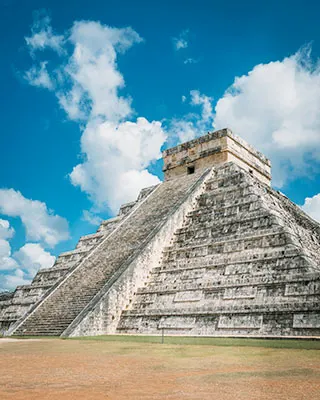
Chichen Itza Tour
Skip the line at Mexico’s most famous archaeological site, visit a colonial town, and swim in a cenote.
2. Coastal Ruins Of Tulum

Just a few hours away from Chichen Itza is the iconic walled city of Tulum perched on a cliff overlooking the sea. Tulum’s ruins feature a beautiful Caribbean beach (that you can swim at!), with incredible views all around.
Tulum was a major trading and religious center for the Maya between the 11th and 16th centuries. They traded turquoise, jade, cotton, food, copper bells, axes, and chocolate.
Because of Tulum’s prime location along the touristic Riviera Maya coast, it gets a lot of visitors. The site isn’t that big either, so it can get super crowded mid-day.
My favorite part of the Tulum ruins is the Temple of the Frescoes, where you can still see painted murals inside!
➜ Read My Free Guide To Tulum’s Ruins
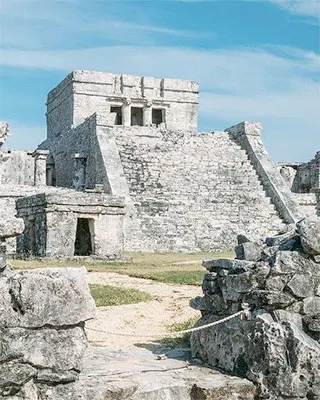
Tour Of Tulum & Coba
Explore 2 archaeological sites in one day, as well as a Mayan village and swimming in a cenote.
3. Maya Ruins Of Coba

Just 40km west of Tulum you’ll reach Coba — one of my favorite Maya ruins in Mexico. Covering 80 square miles and featuring 5 large lakes, Coba is a less popular destination with a real air of mystery about it.
Though archaeologists believe it may one day be one of the largest Mayan excavations, right now it remains mostly untouched so visitors can engage their imagination to dream up the story behind the many mounds and pyramids.
To really appreciate the natural spectacle that is Coba, visitors can still climb 120 steep stone steps to the top of Nohoch Mul – the tallest pyramid in the peninsula – and gaze out over the jungle-covered ruins. Coba also has some excellent freshwater cenotes nearby for swimming!
➜ Read My Free Guide To Visiting Coba

Rent A Car In Mexico
Search both local and international car rental companies to help you find a good deal.
4. Palenque
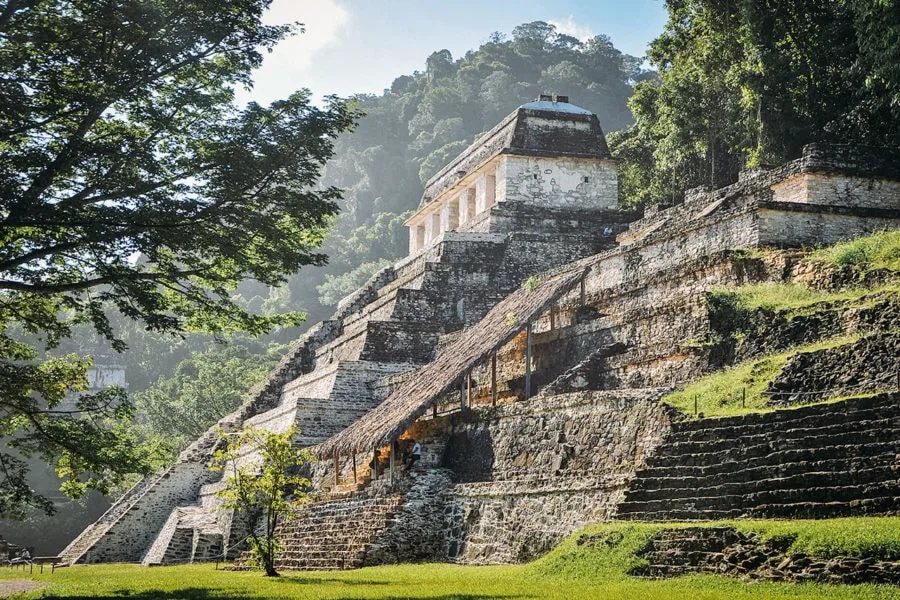
The Mayan ruins of Palenque are steeped in historical significance, and today stand as part of a UNESCO Heritage site surrounded by great trees and wildlife.
One of its highlights is the Temple of Inscriptions, which was built by King Pakal’s first son and provides records of over 180 years of the city’s history.
As well as its historical information, the temple is also home to King Pakal’s tomb, with humidity in the burial chamber so intense that the walls drip with water and individuals can only enter with special authorization.
5. Calakmul Mayan Ruins

The Mayan ruins of Calakmul house two very large pyramids and an extensive system of reservoirs that once provided water to 50,000 Mayans.
Located far away from most tourist attractions in the heart of the Calakmul Biosphere Reserve, a massive protected jungle near the border of Guatemala with wildlife like howler monkeys and jaguars.
Visitors can still climb to the top of these structures and take in the surrounding tropical forests, the expanse of the central plaza and the multiple palaces that lie around it.
Of all the Mayan sites in Mexico, this one is my personal favorite. You can get lost for a full day exploring the site, and due to its remote location, there aren’t many visitors.
➜ Read My Tips For Visiting Calakmul
6. Monte Alban

Monte Alban was one of Mexico’s first pre-Colombian cities, after being founded around 500 BC and supported primarily by agriculture through centuries of development and changing populations.
The city is located in the southern Mexican state of Oaxaca, spanning a great many cultures as it remained inhabited for 13 centuries. It’s also a UNESCO world heritage site due to its historical influence.
Monte Alban is a popular destination for tourists as much of the city is still intact; including temples, tombs, palaces, an astronomical observatory, and even a historical ball court which would have hosted games of Ollama (similar to football).
7. Teotihuacan

The impressive ruins of Teotihuacan outside Mexico City is another mix of culture, with the initial founders still unknown despite features from a variety of cultures apparent in its design. It’s primarily Aztec though.
Items and artifacts found within the city ruins suggest that it was once home to a mix of elite people of the Maya as well as other cultures, making for an interesting historical analysis of the city.
Teotihuacan’s main attraction is the Pyramid of the Moon, which hides a plethora of secrets that are slowly being revealed as archaeological digs continue – years ago researchers discovered the bodies of animals and humans that had been treated to awful brutality in what is assumed to be a ritualistic sacrifice to the Gods.
Visiting the city today, you can explore the Citadel (large open plaza surrounded by temples), the Avenue of the Dead (the main road across the city that aligns with the setting sun once a year) and the Pyramids of the Sun and the Moon – some of Mexico’s largest structures.
8. Ek Balam

Another favorite set of ruins in the Yucatan, near Valladolid, is Ek Balam, meaning Black Jaguar in the Maya language.
You can spend the day exploring and climbing around the site before enjoying a dip in the beautiful X’Canche – a cenote sinkhole full of fresh crystal-blue water.
Ek Balam is also the location of King Ukit Kan Lek Tok’s tomb, which lies within the largest pyramid – standing alongside 45 other ancient structures.
Some of the main highlights are the walls surrounding the site, the views from atop of the highest pyramids and buildings, and the incredible works of art and calligraphy plastered on the walls of some of the remaining buildings.
➜ Read My Tips For Visiting Ek Balam
9. Uxmal Ruins

Uxmal is a set of Mayan ruins located near the Mexican city of Merida, on the West side of the Yucatan Peninsula.
In ancient times, Mayan high priests would perform ceremonies (including sacrifices) atop the religious structures in Uxmal – many hundreds of steps above the ground.
According to Mayan legend, Uxmal’s rounded Pyramid Of the Magician was magically built overnight during a series of challenges issued to a dwarf by the king of Uxmal.
Maya priests doubled as astrologers, and Uxmal was built and designed using astronomy to track the cycles of the moon and the stars. It was also used as a sign of power, as they used their superior knowledge to coincide religious ceremonies with natural phenomena such as the eclipse.
Gazing out over the ruins today, you really do get a sense of the detailed design and work that went into creating this great religious city.
➜ Read My Tips For Visiting Uxmal
10. Edzna
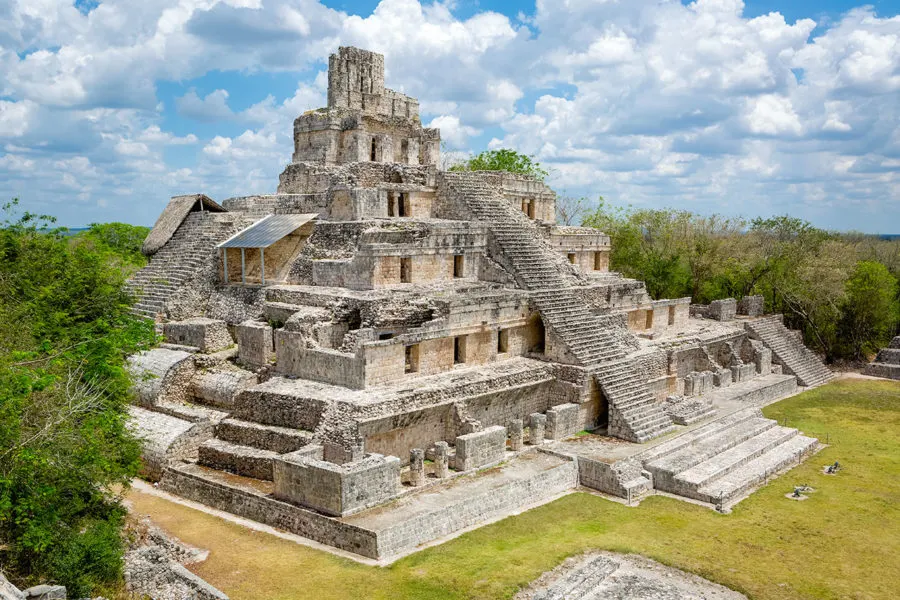
Edzna translates in Mayan to “House of the Itzas”, which has led many to believe that this particular city was the initial home of the Itza family – before they moved on to found the iconic site of Chichen Itza.
Edzna is somewhat of a mystery in many ways, and this contributes to why it is such a great stop on any road trip through Mexico’s Yucatan Peninsula.
Though Edzna was a major city at one point in Mayan history (around 200A), in 1450 it was fully abandoned – with no obvious reason why. Edzna was then “rediscovered” in 1907, and today plays host to a daily Evening Light Show which lights up the city ruins.
When visiting Edzna, make sure to visit the Gran Acropolis, the Temple of the Masks – which showcases two masks, one honoring the Sunrise God and one the Sunset God – and the imposing Palace that faces the Gran Acropolis and is a residential building that runs from the North to the South.
11. El Rey

One of the smaller communities frequented by the Mayans is El Rey – which is actually located in the heart of Cancun. Visiting these ruins can take less than an hour if you’re short on time.
El Rey is considered a temple complex and, when compared to some of the other city ruins, is fairly unspectacular. There are none of the tall pyramids we come to expect with Maya communities, and the architecture is simple and low key.
However, what El Rey does provide is a sense of real history, as you walk amongst the structures and learn how it connected to come of the other Mayan cities nearby – both for trade and for worship pilgrimage.
El Rey is a nice one to visit if you are after some undisturbed exploring, and the nearby Museo Maya will fill the gaps for you in terms of the history and culture of the Mayan communities.
12. Chacchoben

Next up are the ruins of Chacchoben near Mahahual – one of the most popular sites of the Mayan era. Unlike many of its smaller counterparts, Chacchoben has only a portion of the site open to the public.
Many of the original temples are still standing in their ancient condition, awaiting restoration. The city was home to the largest community in its region by 360 AD, and was considered by the Mayans as the center of their ceremonious activity.
The Gran Basamento was the Maya’s most important ritual plaza. Surrounding the ruins is a deep jungle which is now home to a huge variety of plants and creatures, including jaguar, puma and tapir – if you’re lucky – making for an exciting day out!
Another thing to look out for is the traces of red around the base of the temples and structures – proof that these buildings were once coated completely in red paint – though the unrelenting sun is gradually causing further degradation to this as time goes on.
13. Templo Mayor
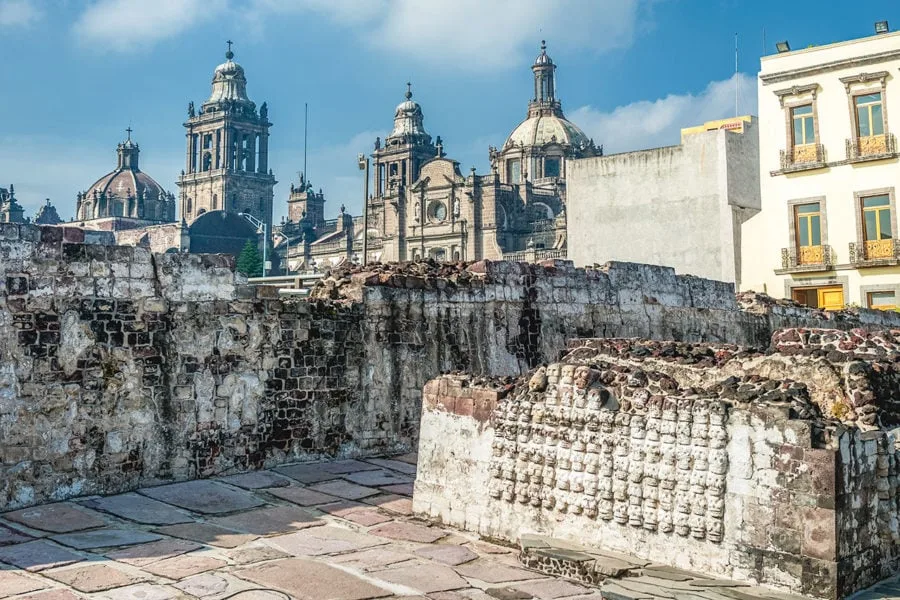
Continuing our exploration into the major cities of the Mayan era, we now reach the Templo Mayor – Spanish for “The Greater Temple” which was once considered the center of the Maya universe.
Templo Mayor is located in present-day Mexico City, considered part of Tenochtitlan and historically dedicated to both the God of War and the God of Rain and Agriculture.
The ruins stand next to an expansive cathedral, and it is said that stones from the temple were used in the construction of the cathedral; linking Mexico City’s levels of history.
Templo Mayor itself was once the scene of both coronations and human sacrifices – with the blood of the sacrifices supposedly feeding the two Gods to whom the temple was dedicated.
14. Izamal

Izamal was an important Mayan pilgrimage site containing one of the heaviest pyramid structures in all of Mesoamerica. It had its own glory days early on, before Chichen Itza took over around 900 AD.
Eventually invaded by the Spanish, Izamal remained a place of importance to the Mayans and the Spanish built a large religious complex which is still a pilgrimage site even today for Mexican Catholics.
In 1993 the site was even visited by Pope John Paul II! There are some interesting annual festivals here which fall in April, May, August and December.
If you pay Izamal a visit, make sure you keep your ears open, as the Maya language is still very much the chosen mother tongue in and around the “yellow town”.
15. El Meco

El Meco is a set of smaller ancient Maya ruins that aren’t well known located just North of Downtown Cancun. There’s even a 41-foot high pyramid!
These ruins were probably related to Isla Mujeres and an important port for the Maya in the Yucatan Peninsula.
To find them, head up Avenida Lopez Portillo (aka the Cancun-Puerto Juarez road) in a rental car, taxi, or collectivo bus. The site is located at KM 27. The ruins are just off the road on the left.
Other Important Mayan Sites
While much of the historic Maya empire was based in present-day Mexico, you can still find many ancient Mayan cities in countries like Guatemala, Honduras, and Belize too.
If you plan to continue your travels to these parts of Central America, I also recommend you stop by sites like:
Tikal – Guatemala
Tikal is one of the largest Mayan settlements in the Americas, located in Guatemala’s Peten basin and Tikal National Park. It was probably called Yax Mutal when it was a thriving city.
The Great Plaza is particularly impressive, flanked on the east and west sides by two great temple-pyramids.
Caracol – Belize
The Mayan site of Caracol in Belize was built around 330 AD, becoming one of the most important political centers of the Maya lowlands through 600-800 AD.
Copan – Honduras
The Copan Ruins feature large open plazas, as well as many altars and monoliths. It is also home to the world’s biggest archeological cut, revealing many layers of the floor beneath the Great Plaza.
It’s also home to the Hieroglyphic Stairway Plaza, with the longest known Mayan inscription (made up from over 1800 glyphs).
Mysteries Of The Maya
So there you have it – a snapshot of Mayan history, told through fifteen different ancient archeological sites.
In spite of the attempted modernization of the world around them, Maya communities have largely succeeded in preserving their identity and traditions; making them somewhat of an attraction for the many tourists who flock to their neighborhoods – both past and present.
Visiting Mexico without seeing at least a few of these historic archeological sites would be a shame, so make sure to pick a few and experience some history and culture on your next trip to Mexico! ★
| Travel Planning Resources For Mexico |
|---|
| Packing Guide Check out my travel gear guide to help you start packing for your trip. Book Your Flight Ready to fly? Here’s how I find the cheapest airline flights. Rent A Car Discover Cars is a great site for comparing car prices to find a deal. Cheap Accommodation Learn how I save money booking hotels & vacation apartments. Protect Your Trip Don’t forget travel insurance! Protect yourself from possible injury & theft abroad. Read why you should always carry travel insurance. |
Enjoy This Article? Pin It!


READ MORE MEXICO TRAVEL TIPS
I hope you enjoyed my guide to the best Mayan ruins in Mexico! Hopefully you found it useful. Here are a few more wanderlust-inducing articles that I recommend you read next:
- Ready to party in Mexico? Here are my top things to do Cancun.
- Road tripping the Riviera Maya? Read my favorite things to do in the Yucatan.
- Save money on your vacation with my ultimate guide to budget travel in Mexico.
- Stay safe out there with these important travel safety tips everyone should know.
- Upgrade your camera with my useful guide to the best travel cameras for any budget.
Have any questions about visiting Mayan Ruins in Mexico? Are you planning a trip? Join the conversation on Facebook, Instagram, or Twitter to share!
